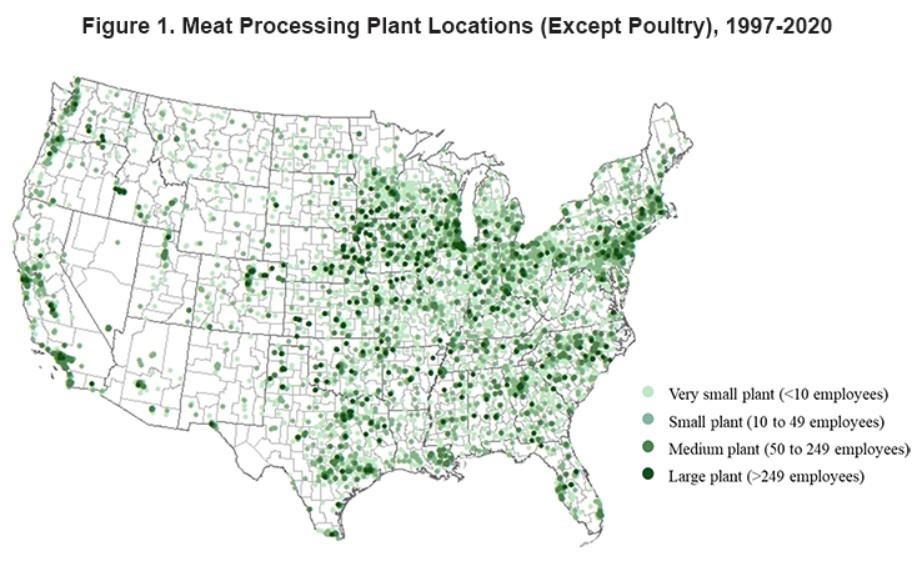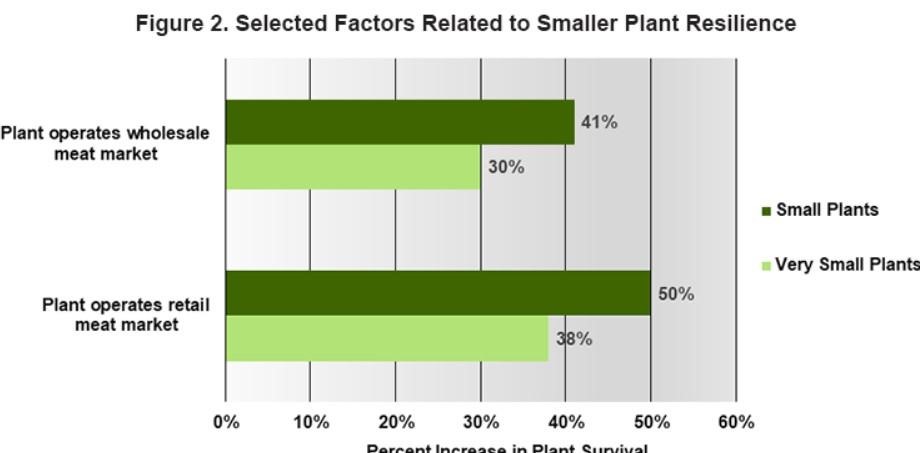By Catherine Isley
From the anti-trust lawsuits of the early 1900s to the present day, the U.S. meat processing industry has long received scrutiny from policymakers and analysts. This scrutiny intensified during the COVID-19 pandemic. During the initial months of the pandemic, the virus spread quickly within meat processing plants, crippling capacity and causing meat price increases for consumers and animal price decreases for farmers (Lusk et al., 2021; Bureau of Labor Statistics, 2022; Martinez et al., 2021).
These issues led to renewed interest from policymakers in supporting the resilience of the meat processing industry, particularly small and medium plants. Since the pandemic began, over $1 billion in Federal dollars has been dedicated to supporting these plants, with sizeable portions of this funding still being distributed (The White House, 2022). Despite the interest and investment in industry resilience, there needs to be more known about what factors may help meat processing plants survive. This farmdoc daily draws on a recent Rural and Farm Finance Policy Analysis Center and University of Illinois study to help fill this knowledge gap (Isley & Low, 2023).
Meat Processing Plants Tend to be Located Close to People
Overall, most plants are in the more populous eastern half of the U.S. (Figure 1). There is a strong correlation between population and the number of plants in a county, with 86% of plants located in metro or metro-adjacent counties, likely due to proximity to the workforce and consumers. The average plant in our study dataset, spanning 1997 to 2020, survived for 9.7 years. 62% of plants in the dataset failed, with failures seeing a cyclical pattern – failures peaked around 1997, 2005–2007, and 2019. Nearly half of the plants in our study had between four and ten employees when the plant began operations, while only 5% had more than 250 employees.

Small Plant Survival Was Related to Business Diversification
The smaller a plant was, the less likely it was to survive. We found that business diversification was the most critical factor related to small plant survival; smaller plants (fewer than 50 employees) that operated a retail meat market were 38% to 50% less likely to fail than those that did not (Figure 2). Smaller plants that operated a wholesale meat market were between 30% and 41% less to fail than those that did not. These relationships held for smaller plants in both rural and urban areas. These findings suggest that having an outlet for selling products – not just selling a service in the form of custom processing – may increase small plant success.

Large Plant Survival Was Related to Local Context
Local context, particularly factors related to workforce quality and quantity, was most strongly associated with large plant survival. For example, large plants were more likely to survive in urban counties; additional analyses suggest this is due to the availability of labor. Additionally, large plants in rural areas were more likely to survive where the immigrant population was the highest, as immigrant workers represent a crucial labor pool for meat processing plants.
Additionally, large nonmetro plants were more likely to survive where local plant concentration – measured in various ways – was higher. However, concentration did not appear related to the survival of smaller or medium-sized plants.
Implications
Our results suggest several policy implications:
- Findings suggest that selling processed meat, versus only conducting custom processing, may increase small plant survival. Thus, technical assistance may be warranted to help smaller plants (5 to 50 employees) diversify into operating retail and/or wholesale meat markets. However, smaller plants operating retail meat markets generally sell niche products that are not price competitive with commodity products. Thus, sufficient local demand and income will be needed to support these products; this solution is not one-size-fits-all.
- Workforce-related solutions, such as safety investments, automation research and development, and increasing the number of work visas for food processing workers, may increase large plant survival, especially for plants in rural America.
- Concentration policies may not work as intended; we find some evidence that industry concentration may be protective for large, rural plants, though this evidence has caveats.
- The smallest plants in our study had the highest failure rates, which has important implications for policymakers investing in these small plants.
- Because very small female-operated rural plants had higher failure rates than their male-operated counterparts, technical assistance for these plants may be warranted.
These results may be especially relevant to decision-makers who aim to support meat processing in their state or region. For example, Illinois has made available $6 million in the form of capital grants for eligible meat processing companies to expand production capacity in Illinois, including establishing new facilities or expanding the scale and scope of existing facilities’ production. Missouri put nearly $17 million in CARES Act funds towards developing and supporting small meat processors, and Iowa did the same with $4 million.
Source : illinois.edu